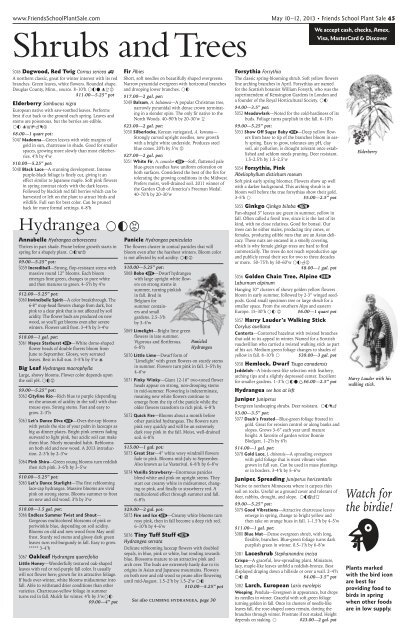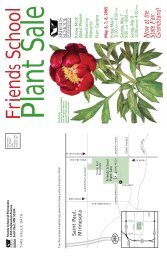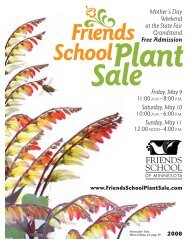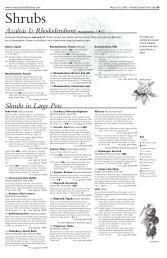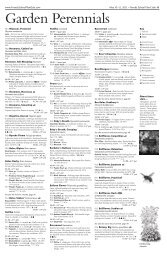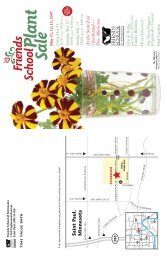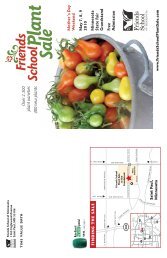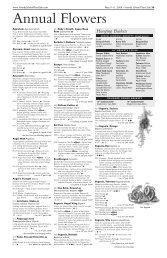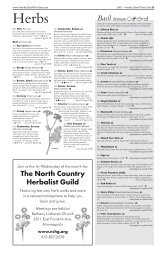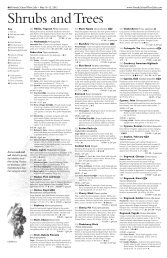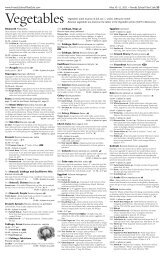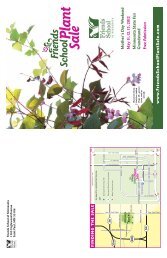View the 2013 56-page PDF here - Friends School Plant Sale
View the 2013 56-page PDF here - Friends School Plant Sale
View the 2013 56-page PDF here - Friends School Plant Sale
Create successful ePaper yourself
Turn your PDF publications into a flip-book with our unique Google optimized e-Paper software.
www.<strong>Friends</strong><strong>School</strong><strong>Plant</strong><strong>Sale</strong>.com May 10–12, <strong>2013</strong> • <strong>Friends</strong> <strong>School</strong> <strong>Plant</strong> <strong>Sale</strong> 45<br />
Shrubs and Trees<br />
We accept cash, checks, Amex,<br />
Visa, MasterCard & Discover<br />
S046 Dogwood, Red Twig Cornus sericea ß<br />
A nor<strong>the</strong>rn classic, great for winter interest with its red<br />
branches. Green leaves, white flowers. Rounded shape.<br />
Douglas County, Minn., source. 8–10’h Í∏Ó Ω˜¥<br />
$11.00—5.25” pot<br />
Elderberry Sambucus nigra<br />
European native with saw-too<strong>the</strong>d leaves. Performs<br />
best if cut back to <strong>the</strong> ground each spring. Leaves and<br />
stems are poisonous, but <strong>the</strong> berries are edible.<br />
Í∏ Ω∫´Âç¥<br />
$8.00—1 quart pot:<br />
S047 Madonna—Green leaves with wide margins of<br />
gold in sun, chartreuse in shade. Good for smaller<br />
spaces, growing more slowly than most elderberries.<br />
4’h by 4’w<br />
$10.00—5.25” pot:<br />
S048 Black Lace—A stunning development. Intense<br />
purple-black foliage is finely cut, giving it an<br />
effect similar to Japanese maple. Soft pink flowers<br />
in spring contrast nicely with <strong>the</strong> dark leaves.<br />
Followed by blackish red fall berries which can be<br />
harvested or left on <strong>the</strong> plant to attract birds and<br />
wildlife. Full sun for best color. Can be pruned<br />
back for more formal settings. 6–8’h<br />
Hydrangea 긴<br />
Annabelle Hydrangea arborescens<br />
Thrives in part shade. Prune before growth starts in<br />
spring for a shapely plant. Í∏∫¥<br />
$9.00—5.25” pot:<br />
S059 Incrediball—Strong, flop-resistant stems with<br />
massive round 12” blooms. Each bloom<br />
emerges lime green, changes to pure white<br />
and <strong>the</strong>n matures to green. 4–5’h by 4’w<br />
$12.00—5.25” pot:<br />
S060 Invincibelle Spirit—A color breakthrough. The<br />
6-8” mop-head flowers change from dark, hot<br />
pink to a clear pink that is not affected by soil<br />
acidity. The flower buds are produced on new<br />
wood, so you’ll get blooms even after severe<br />
winters. Flowers until frost. 3–4’h by 3–4’w<br />
$18.00—1 gal. pot:<br />
S061 Hayes Starburst ◊—White dome-shaped<br />
flower heads of double florets bloom from<br />
June to September. Glossy, very serrated<br />
leaves. Best in full sun. 3–5’h by 5’w Ω<br />
Big Leaf Hydrangea macrophylla<br />
Large, showy blooms. Flower color depends upon<br />
<strong>the</strong> soil pH. 긴<br />
$9.00—5.25” pot:<br />
S062 Cityline Rio—Rich blue to purple (depending<br />
on <strong>the</strong> amount of acidity in <strong>the</strong> soil) with chartreuse<br />
eyes. Strong stems. Fast and easy to<br />
grow. 2–3’h<br />
S063 Let’s Dance Diva ◊—Over-<strong>the</strong>-top blooms<br />
with petals <strong>the</strong> size of your palm in lacecaps as<br />
big as dinner plates. Bright pink centers fading<br />
outward to light pink, but acidic soil can make<br />
<strong>the</strong>m blue. Nicely mounded habit. Reblooms<br />
on both old and new wood. A <strong>2013</strong> introduction.<br />
2–3’h by 2–3’w<br />
S064 Pink Shira—Green young blooms turn reddish<br />
<strong>the</strong>n rich pink. 3–6’h by 3–5’w<br />
$10.00—5.25” pot:<br />
S065 Let’s Dance Starlight—The first reblooming<br />
lace-cap hydrangea. Massive blooms are vivid<br />
pink on strong stems. Blooms summer to frost<br />
on new and old wood. 3’h by 3’w<br />
$18.00—1.5 gal. pot:<br />
S066 Endless Summer Twist and Shout—<br />
Gorgeous multicolored blossoms of pink or<br />
periwinkle blue, depending on soil acidity.<br />
Blooms on old and new wood from May until<br />
frost. Sturdy red stems and glossy dark green<br />
leaves turn red-burgundy in fall. Easy to grow.<br />
***** 3–4’h<br />
S067 Oakleaf Hydrangea quercifolia<br />
Little Honey—Wonderfully textured oak-shaped<br />
leaves with red or red-purple fall color. It usually<br />
will not flower <strong>here</strong>; grown for its attractive foliage.<br />
If buds over-winter, white blooms midsummer into<br />
fall. Able to withstand drier conditions than o<strong>the</strong>r<br />
varieties. Chartreuse-yellow foliage in summer<br />
turns red in fall. Mulch for winter. 4’h by 3’wÍ∏<br />
$9.00—4” pot<br />
Fir Abies<br />
Short, soft needles on beautifully shaped evergreens.<br />
Narrow pyramidal evergreen with horizontal branches<br />
and drooping lower branches. Í∏<br />
$17.00—2 gal. pot:<br />
S049 Balsam, A. balsamea—A popular Christmas tree,<br />
narrowly pyramidal with dense crown terminating<br />
in a slender spire. The only fir native to <strong>the</strong><br />
North Woods. 40–90’h by 20–30’w ˜<br />
$23.00—2 gal. pot:<br />
S050 Silberlocke, Korean variegated, A. koreana—<br />
Strongly curved upright needles, new growth<br />
with a bright white underside. Produces steel<br />
blue cones. 20’h by 5’w ¥<br />
$27.00—2 gal. pot:<br />
S051 White Fir, A. concolor ◊—Soft, flattened pale<br />
blue-green needles have uniform coloration on<br />
both surfaces. Considered <strong>the</strong> best of <strong>the</strong> firs for<br />
tolerating <strong>the</strong> growing conditions in <strong>the</strong> Midwest.<br />
Prefers moist, well-drained soil. 2011 winner of<br />
<strong>the</strong> Garden Club of America’s Freeman Medal.<br />
40–70’h by 20–30’w<br />
Panicle Hydrangea paniculata<br />
The flowers cluster in conical panicles that will<br />
bloom even after <strong>the</strong> harshest winters. Bloom color<br />
is not affected by soil acidity. 긴<br />
$10.00—5.25” pot:<br />
S068 Bobo ◊—Dwarf hydrangea<br />
with large upright white flowers<br />
on strong stems in<br />
summer, turning pinkish<br />
in fall. Bred in<br />
Belgium for<br />
summer containers<br />
and small<br />
gardens. 2.5–3’h<br />
by 3–4’w<br />
S069 Limelight—Bright lime green<br />
flowers in late summer.<br />
Vigorous and floriferous. Panicled<br />
6–8’h<br />
Hydrangea<br />
S070 Little Lime—Dwarf form of<br />
‘Limelight’ with green flowers on sturdy stems<br />
in summer. Flowers turn pink in fall. 3–5’h by<br />
4–6’w<br />
S071 Pinky Winky—Giant 12-16” two-toned flower<br />
heads appear on strong, non-drooping stems<br />
in mid-summer. Flowering is indeterminate,<br />
meaning new white flowers continue to<br />
emerge from <strong>the</strong> tip of <strong>the</strong> panicle while <strong>the</strong><br />
older flowers transform to rich pink. 6–8’h<br />
S072 Quick Fire—Blooms about a month before<br />
o<strong>the</strong>r panicled hydrangeas. The flowers turn<br />
pink very quickly and will be an extremely<br />
dark rosy pink in <strong>the</strong> fall. Moist, well-drained<br />
soil. 6–8’h<br />
$15.00—1 gal. pot:<br />
S073 Great Star—4” white wavy windmill flowers<br />
fade to pink. Blooms mid–July to September.<br />
Also known as Le Vasterival. 6–8’h by 6–8’w<br />
S074 Vanilla Strawberry—Enormous panicles<br />
blend white and pink on upright stems. They<br />
start out creamy white in midsummer, changing<br />
to pink, and finally to strawberry red. A<br />
multicolored effect through summer and fall.<br />
6–8’h<br />
$29.00—2 gal. pot:<br />
S075 Fire and Ice ◊—Creamy white blooms turn<br />
rosy pink, <strong>the</strong>n in fall become a deep rich red.<br />
6–10’h by 4–6’w<br />
S076 Tiny Tuff Stuff ◊<br />
Hydrangea serrata<br />
Delicate reblooming lacecap flowers with doubled<br />
sepals, in blue, pink or white, but tending towards<br />
blue. Blossoms mature to an attractive pink and<br />
arch over. The buds are extremely hardy due to its<br />
origins in Asian and Japanese mountains. Flowers<br />
on both new and old wood so prune after flowering<br />
until mid-August. 1.5–2’h by 1.5–2’w Í∏<br />
$10.00—5.25” pot<br />
See also CLIMBING HYDRANGEA, <strong>page</strong> 30<br />
Forsythia Forsythia<br />
The classic spring-blooming shrub. Soft yellow flowers<br />
line arching branches in April. Forsythias are named<br />
for <strong>the</strong> Scottish botanist William Forsyth, who was <strong>the</strong><br />
superintendent of Kensington Gardens in London and<br />
a founder of <strong>the</strong> Royal Horticultural Society. Í∏<br />
$4.00—3.5” pot:<br />
S052 Meadowlark—Noted for <strong>the</strong> cold-hardiness of its<br />
buds. Foliage turns purplish in <strong>the</strong> fall. 6–10’h<br />
$9.00—5.25” pot:<br />
S053 Show Off Sugar Baby ◊—Deep yellow flowers<br />
from base to tip of <strong>the</strong> branches bloom in early<br />
spring. Easy to grow, tolerates any pH, clay<br />
soil, air pollution, is drought tolerant once established<br />
and seldom needs pruning. Deer resistant.<br />
1.5–2.5’h by 1.5–2.5’w<br />
S054 Forsythia, Pink<br />
Abeliophyllum distichum roseum<br />
Soft pink early spring bloomer. Flowers show up well<br />
with a darker background. This arching shrub is in<br />
bloom well before <strong>the</strong> true forsythias show <strong>the</strong>ir gold.<br />
3–5’h Í<br />
$5.00—2.5” pot<br />
S055 Ginkgo Ginkgo biloba ◊<br />
Fan-shaped 3” leaves are green in summer, yellow in<br />
fall. Often called a fossil tree, since it is <strong>the</strong> last of its<br />
kind, with no close relatives. Good for bonsai. Our<br />
trees can be ei<strong>the</strong>r males, producing tiny cones, or<br />
females, producing edible nuts that are an Asian delicacy.<br />
These nuts are encased in a smelly covering,<br />
which is why female ginkgo trees are hard to find<br />
commercially. The trees do not reach reproductive age<br />
and publicly reveal <strong>the</strong>ir sex for two to three decades<br />
or more. 50–75’h by 50–60’w Í∏Â¥<br />
$8.00—1 gal. pot<br />
S0<strong>56</strong> Golden Chain Tree, Alpine ◊<br />
Laburnum alpinum<br />
Hanging 10” clusters of showy golden yellow flowers<br />
bloom in early summer, followed by 2-3” winged seedpods.<br />
Good small specimen tree or large shrub for a<br />
smaller space. From <strong>the</strong> sou<strong>the</strong>rn Alps and eastern<br />
Europe. 15–30’h Í∏ ¥ $6.00—1 quart pot<br />
S057 Harry Lauder’s Walking Stick<br />
Corylus avellana<br />
Contorta—Contorted hazelnut with twisted branches<br />
that add to its appeal in winter. Named for a Scottish<br />
vaudevillian who carried a twisted walking stick as part<br />
of his act. Medium green foliage changes to shades of<br />
yellow in fall. 8–10’h Í $39.00—3 gal. pot<br />
S058 Hemlock, Dwarf Tsuga canadensis<br />
Jeddeloh—A birds-nest-like selection with fea<strong>the</strong>ry,<br />
arching tips and a slightly depressed center. Excellent<br />
for smaller gardens. 1–3’h Í∏Ó ‰ $6.00—2.5” pot<br />
Hydrangea see box at left<br />
Juniper Juniperus<br />
Evergreen landscaping shrubs. Deer resistant. Í∏çÂ<br />
$3.00—3.5” pot:<br />
S077 Daub’s Frosted—Blue-green foliage frosted in<br />
gold. Great for erosion control or along banks and<br />
slopes. Grows 3–6” each year until mature<br />
height. A favorite of garden writer Bonnie<br />
Blodgett. 1–2’h by 6’h<br />
$14.00—1 gal. pot:<br />
S078 Gold Lace, J. chinensis—A spreading evergreen<br />
with gold foliage that is most vibrant when<br />
grown in full sun. Can be used in mass plantings<br />
or in borders. 3–4’h by 5–6’w<br />
Juniper, Spreading Juniperus horizontalis<br />
Native to nor<strong>the</strong>rn Minnesota w<strong>here</strong> it carpets thin<br />
soil on rocks. Useful as a ground cover and tolerant of<br />
deer, rabbits, drought, and slope. Í∏˝Â˜<br />
$9.00—5.25” pot:<br />
S079 Good Vibrations—Attractive chartreuse leaves<br />
emerge in spring, change to bright yellow and<br />
<strong>the</strong>n take on orange hues in fall. 1–1.5’h by 4–5’w<br />
$11.00—1 gal. pot:<br />
S080 Blue Mat—Dense evergreen shrub, with long,<br />
flexible, branches. Blue-green foliage turns dark<br />
purplish green in winter. 0.5–1’h by 6–8’w<br />
S081 Laceshrub Stephanandra incisa<br />
Crispa—A graceful, low-spreading plant. Miniature,<br />
lacy, maple-like leaves unfold a reddish-bronze. Best<br />
displayed draping down a hillside or over a wall. 2–4’h<br />
Í∏ ˝<br />
$4.00—3.5” pot<br />
S082 Larch, European Larix eurolepis<br />
Weeping, Pendula—Evergreen in appearance, but drops<br />
its needles in winter. Graceful with soft green foliage<br />
turning golden in fall. Once its clusters of needle-like<br />
leaves fall, <strong>the</strong> rose-shaped cones remain, dotting <strong>the</strong><br />
branches through winter. Prostrate if not staked. Height<br />
depends on staking. Í<br />
$23.00—2 gal. pot<br />
Elderberry<br />
Harry Lauder with his<br />
walking stick.<br />
Watch for<br />
<strong>the</strong> birdie!<br />
ı<br />
<strong>Plant</strong>s marked<br />
with <strong>the</strong> bird icon<br />
are best for<br />
providing food to<br />
birds in spring<br />
when o<strong>the</strong>r foods<br />
are in low supply.


